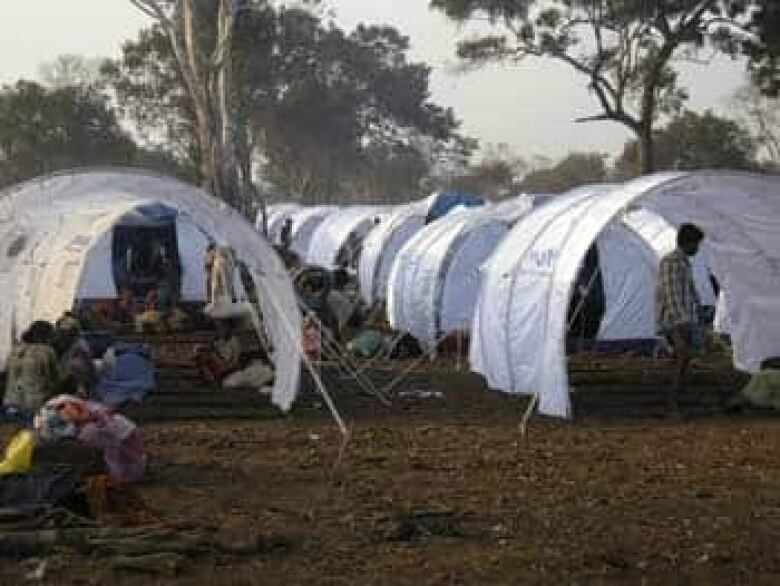Setting up a tent city

Almost a million tents were delivered and erected in the various emergency camps set up after the earthquake. A year later, there were still about 35,000 people living in temporary tent cities, the United Nations said.

Tent cities began springing up in the Port-au-Prince area a day after the earthquake hit Haiti on Jan. 12. Within a few days, approximately 50,000 people had set up makeshift tents mostly made from pieces of fabric on a golf course overlooking the capital.
On Jan. 18, the UN World Food Programme announced plans fortemporary campsthat would house 100,000 outside Port-au-Prince. The tent cities are expected to each house around 10,000 people.
Tent cities set up by international aid agencies are supposed to meet certain standards.
Those standards were set by theSphere Project, an initiative launched in 1997 by several humanitarian agencies, including the Red Cross and Red Crescent societies, with the goal of improving the quality of assistance people affected by disasters receive.
The Sphere standards for tent cities include:
- A minimum covered floor area of 3.5 square metres per person.
- Shelters should be equipped with long-lasting insecticide-treated nets (known as LLINs) for each sleeping space to prevent malaria transmission.
- Essential household and livelihood activities should be able to be carried out within the shelter.
- The total area of the camp should work out to 45 square metres for each person residing in the camp. That area would include room for family tents, space between the tents, roads, footpaths, external cooking areas if needed, schools, recreational areas, toilets, water storage and distribution areas, markets, administration facilities and limited kitchen gardens for individual households.
- Ground conditions must be suitable for excavating toilet pits where this is the primary sanitation system. The site gradient should not exceed six per cent - unless extensive drainage and erosion-control measures are taken - or be less than one per cent to provide for adequate drainage.
- Waste should be disposed of in a pit, away from shelters and protected from rodents to reduce the exposure of the population to rodents and other carriers of disease.
- The lowest point of the site should be not less than three metres above the estimated level of the water table in the rainy season.
- Space between tents should be two metres to prevent overcrowding and the diseases associated with overcrowding.

The medical aid organization Doctors Without Borders/Mdecins sans Frontires (MSF) said on Jan. 19 that a plane loaded with 12 tonnes of medical supplies was turned away from the airport three times in the previous three days.
Standards for services and infrastructure
- One water tap per community (80 to 100 people).
- One latrine per family (six to 10 people).
- One health centre per site (20,000 people).
- One referral hospital per 10 sites (200,000 people).
- One school block per sector (5,000 people).
- Four distribution points per site (20,000 people).
- One market per site (20,000 people).
- One feeding centre per site (20,000 people).
- Two refuse drums per community (80 to 100 people).
Source:UNHCR Handbook for Emergencies.
"We have had five patients in Martissant health centre die for lack of the medical supplies that this plane was carrying," Loris de Filippi, emergency co-ordinator for MSF's Choscal Hospital in the Cit Soleil section of Port-au-Prince, said in a news release. "I have never seen anything like this We were forced to buy a saw in the market to continue amputations. We are running against time here." It's expected to take another week for the city's port and the port at the nearby city of Jacmel, where Canada's Disaster Assistance Response Team is stationed to be fully operational.
By then, the office of the United Nations High Commissioner for Human Rights (UNHCR) is expected to have sent over two planeloads of tents and plastic sheets enough for more than 92,000 people. The organization has already sent six hospital tents to Haiti.
The tent cities that have sprung up so far have been unplanned and unstructured. According to the UNHCR, crowded, unplanned camps are "the worst possible option for refugee accommodation and an intolerable strain on local services."
"However, this may be the only option because of decisions by the host country or simply because of a lack of sufficient land," the UNHCR says in its guidelines.
Sample daily food rations per person
- 400 grams rice, wheat or maize
- 60 grams peas, beans or lentils
- 25 grams vegetable or butter oil
- 100 grams fortified blended food (eg. corn-soya blend)
- 15 grams sugar
- 5 grams salt
Total calories: 2,261
Total protein: 71.2 grams
Total fat: 47.9 grams
So far, tent camps in Port-au-Prince have sprung up:
- Across the street from the badly damaged presidential palace.
- At the Petionville Club, a damaged country club that's home to Haiti's only golf course in an affluent suburb east of Port-au-Prince.
- A stadium.
While the camps weren't planned and set up according toSphere recommendations, some emergency supplies are getting to the residents. The U.S. military is handing out food, water and medical supplies at the Petionville camp.
It's expected to take several days before the first planned tent cities are ready.
The graphic below shows a camp that conforms to international guidelines.












_(720p).jpg)


 OFFICIAL HD MUSIC VIDEO.jpg)
.jpg)



























































































